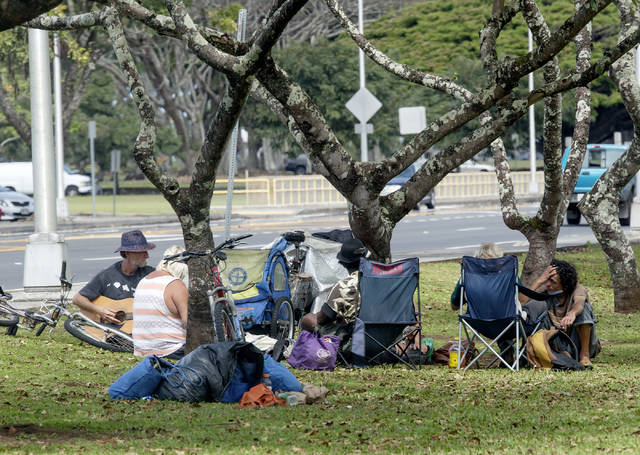James Hanato, 49, slept Tuesday night on the concrete behind an office building in Hilo. ADVERTISING James Hanato, 49, slept Tuesday night on the concrete behind an office building in Hilo. He’s been homeless since January and is in town
James Hanato, 49, slept Tuesday night on the concrete behind an office building in Hilo.
He’s been homeless since January and is in town for a couple of days before heading back to Kona by bus.
The Big Island seems like a warm, inviting place to live. But at 2 a.m., when you live on the street, Hanato said, it’s cold.
“Cold,” he repeats a second time, squinting his eyes for what he knows he likely will experience again and again. “For some reason, the wind, like, blows right down off the mountain. It gets pretty cold down here when the wind blows. I kind of sleep out in the open. I don’t really hide in the bushes.”
Homelessness in Hawaii County decreased dramatically in the past year, according to the office of Gov. David Ige, who declared homelessness an emergency in 2015.
According to the Homeless Point in Time Count of individuals and families in January, there’s been a 32 percent drop in homelessness in the county — the largest drop in the state. Countywide, there were 953 homeless individuals this year, compared to 1,394 in 2016.
In Maui County, homelessness dropped 22 percent (896 in 2017, compared with 1,145 in 2016). In Kauai County, it dropped 7 percent (412 in 2017, 442 in 2016). But it increased nearly a half percent on Oahu (4,959 in 2017, 4,940 in 2016).
Statewide, 7,220 people were counted as homeless in 2017, compared with 7,921 in 2016, a 9 percent drop.
Ige said in a statement that the state has partnered with every mayor in every county, hosted housing summits and sought to place families in permanent housing.
“This report is proof that our collective efforts are working,” Ige said.
Jamilia Epping, director of events and spokeswoman at The Food Basket, Hawaii Island’s food bank, said she remains concerned about statistics from the same time period from her nonprofit.
“We have actually seen an increase in people coming in for emergency boxes,” she said.
Those went from 12,000 per month in 2016, to 13,649 per month now.
Some of those served are homeless, Epping said.
Also, “I think a lot of people who are hungry are at risk for homelessness,” she said.
The homelessness count, she said, “relies on people going out and counting people — there’s a lot of room for error.”
The first, natural reaction might be joy to see the number of people living on the streets drop.
But, Epping said, those numbers affect the availability of funds, such as federal grants that are intended to offset homelessness.
Hanato stays at shelters in Kona and Hilo and thinks his life will work out OK, keeping a remarkably positive attitude despite the lack of a home.
He said he’s not sure how much HOPE Services, which operates the Hilo shelter, helps the homeless because it’s a small organization. He thinks two people could split bunk beds and stay in the same room to increase the slots available for overnight stays.
“When bad things start happening at home, I walk away. I hit the streets,” he said.
Most on the streets don’t like accepting handouts because they fear the food might be poisoned, or they wonder about the potential motivations of the person offering assistance, such as potential abuse or theft.
But, he said, “I get hungry, I’m going to ask for a dollar here, a dollar there and, as soon as I get enough, I’m going to go buy a sandwich.”
Ige acknowledged there’s more to do, and the focus will remain on increasing affordable housing.
Email Jeff Hansel at jhansel@hawaiitribune-herald.com.



